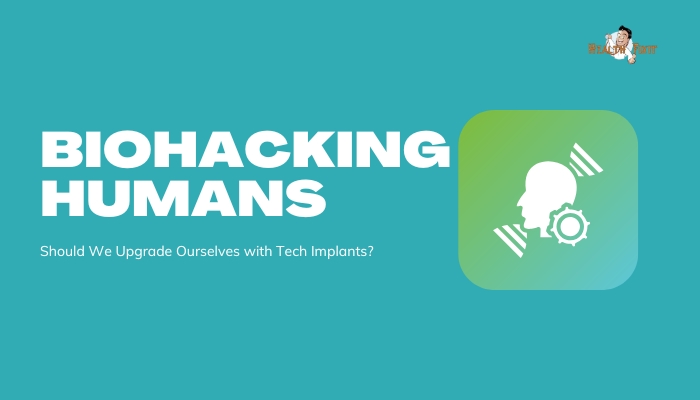Introduction
At first glance, the idea of implanting technology into human bodies may sound like pure science fiction. Yet biohackers worldwide experiment with NFC chips under their skin,
some advanced prostheses already link with the nervous system, and clinical trials test invasive brain-computer interfaces (BCIs).
These “augmentations” promise new capabilities—keyless entry with a wave of the hand, or mental control over robotic limbs.
But they also invite crucial questions about identity, privacy, and safety. This article explores the current state of tech implants,
how they are changing our notion of “human,” and the ethical trade-offs that come with merging biology and technology more tightly than ever before.
A Brief History of Biohacking
From DIY Subdermals to Mainstream Medicine
Initially, biohackers in small “grinder” communities started embedding tiny magnets or RFID chips beneath the skin—for convenience or novelty.
Meanwhile, on a medical front, cochlear implants and pacemakers served as well-established examples of beneficial tech implants
. Over time, the lines blurred, with more mainstream acceptance of certain implants to restore or even enhance capabilities.
Current Categories of Implants
- NFC or RFID Chips: Useful for keyless door unlocks, storing digital business cards, or encrypted data.
- Magnetic Implants: Let users sense electromagnetic fields or handle tiny metal objects.
- Medical BCIs: Help paralyzed patients move robotic arms or communicate.
- Experimental Eye/Retina Implants: Potential partial vision restoration for some blind individuals.
Though mainstream acceptance is limited, these developments lay the groundwork for a future of deeper human-technology integration.
Potential Benefits of Tech Implants
Medical Advancements
- Prosthetics: Advanced neuro-controlled limbs for amputees, bridging the gap between muscle signals and robotic appendages.
- Sensory Restoration: Implants for hearing (cochlear) or sight (retinal) return lost faculties to individuals with disabilities.
- Seizure and Pain Management: Deep brain stimulation or spinal cord implants can reduce epileptic episodes or chronic pain, providing major quality-of-life improvements.
Convenience and Personal Enhancement
Beyond medical necessity, some chips offer day-to-day ease—like unlocking phones, starting cars, or storing secure data
. Future implants might offer novel senses (infrared perception, for instance) or memory augmentation tools.
Some envision more robust immune monitoring or real-time health tracking integrated at a biological level.
Community Building and Self-Expression
Biohacking fosters a sense of identity and creative expression for enthusiasts. Similar to tattoos or piercings, implants can be a statement of personal freedom or exploration of the human-machine boundary.
Ethical and Societal Concerns
Privacy and Security
Implanted chips might hold personal data or connect to networks. If not designed with robust encryption,
they could be hacked—exposing sensitive info or allowing unauthorized manipulation.
Regulation and robust cybersecurity become critical in an era where someone’s body is directly connected to digital systems.
Inequality and Social Implications
If advanced implants confer cognitive or physical advantages (like an expanded memory or super-accurate sense of direction), they may exacerbate socio-economic divides—wealthier individuals can afford “upgrades,” potentially broadening inequality.
Identity and Autonomy
Where do we draw the line between a medically necessary implant and a superhuman enhancement? Could future employers or institutions pressure individuals to adopt implants for improved
performance? Maintaining personal choice and bodily autonomy is central to the debate.
Health and Safety Risks
Surgical and Infection Risks
Any implanted device can cause complications: surgical errors, infections, or foreign-body reactions. Minimally invasive insertion can reduce these, but not all implants are simply subdermal; BCIs, for example, require neurosurgery.
Device Failure or Battery Issues
An internal device might fail. Revisions or explantations are more complex than replacing a wearable. Battery life also matters; some solutions rely on wireless charging, introducing possible short- or long-term reliability concerns.
Psychological Effects
Adopting an implant can change self-image or daily habits. Some might feel anxious or uncertain about being partially “mechanical.” Thorough psychological support is advisable, especially for advanced or experimental implants.
The Future of Biohacking: Integration or Oversight?
Toward a Wearable-to-Implant Progression
Some experts foresee a progression: we start with wearable trackers (smartwatches, rings), then move to more discreet subdermal versions for convenience or advanced metrics. As the line between health need and personal enhancement blurs, acceptance grows.
Potential Legislation and Standards
Given privacy, safety, and moral questions, governments may set standards—like disclaimers that chips can’t be forced upon employees or data must be anonymized. Clear frameworks will help mainstream adoption while preventing misuse or coerced implantation.
Synergy with AI and Extended Reality
Combining implanted sensors or brain interfaces with AI-based analytics could drastically expand human capabilities
. Some envision next-level gaming or a “shared telepathy” in VR contexts. Though such developments remain futuristic, incremental progress in each domain fosters the path forward.
Practical Recommendations
- Research Thoroughly: If you’re curious about implants for convenience, pick a reputable device and practitioner. Check local laws and read up on success/failure rates.
- Consult Healthcare Providers: For medical implants—like neural prosthetics or deep brain stimulation—ensure an experienced clinical team supports you, including post-op follow-ups.
- Consider Ethical and Social Repercussions: Evaluate how an implant might impact relationships, identity, or job prospects. Transparent discussion with family and peers fosters acceptance.
- Maintain Security Measures: If your device connects digitally, practice best cybersecurity hygiene—strong passwords, updated firmware, encryption, etc.
Conclusion
Biohacking—especially through technological implants—blurs the boundary between biology and machine. Whether aiming to restore lost functions (prosthetics,
hearing implants) or bestow new capabilities (NFC implants, advanced BCIs), these “augments” offer remarkable possibilities for medicine,
convenience, and self-expression. But as we inch closer to the notion of “upgraded humans,” we face weighty privacy concerns,
health risks, and moral debates about equality and identity. Finding a balanced path—where safe, beneficial implants co-exist with personal autonomy and robust security—will define how broad or niche the next wave of biohacking becomes.
References
- Choi H, Shin D, Shin S, Lee Y. The concept of body hacking and its influence on the future of wearable technology. Comput Ind Eng. 2021;157:107268.
- Warwick K. Implantable chips in humans—social and ethical implications. Sci Eng Ethics. 2010;16(3):517–529.
- Chen Y, Deng Y, Mao D, Zhao C. Current status and future prospects of neural interface technology. Neural Regen Res. 2019;14(1):130–139.
- Bergsland J, et al. Implantable sensors and devices in the era of the IoMT: challenges and opportunities. Telemed J E Health. 2021;27(3):247–256.
- Graafstra A. RFID implants: The rise of the cyborgs. IEEE Potentials. 2020;39(4):13–17.
- Zhang W, et al. Privacy and data security in subdermal technology. J Inf Secur. 2021;12(2):98–106.
- BMBF. The next wave of prosthetics and advanced bionic implants. Sci Eng Rep. 2019;2(2):145–158.
- Reardon S. Brain–computer interfaces in neurosciences—where do we stand? Nat News. 2018; Online.
- Johnson E. Ethical frameworks for biohacking. Hastings Cent Rep. 2017;47(S2):S2–S5.
- Schermer M. The future of the body: ethical aspects of body hacking. Sci Eng Ethics. 2019;25(3):719–737.




